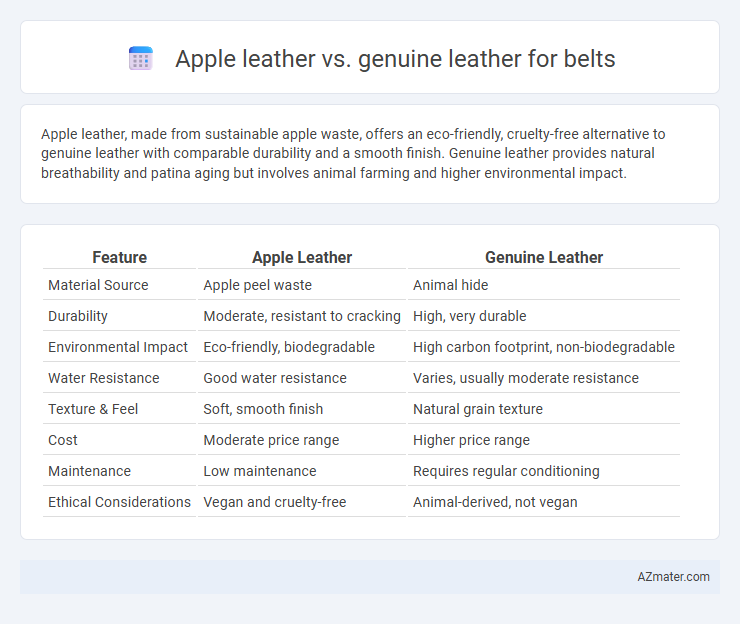Apple leather, made from sustainable apple waste, offers an eco-friendly, cruelty-free alternative to genuine leather with comparable durability and a smooth finish. Genuine leather provides natural breathability and patina aging but involves animal farming and higher environmental impact.
Table of Comparison
| Feature | Apple Leather | Genuine Leather |
|---|---|---|
| Material Source | Apple peel waste | Animal hide |
| Durability | Moderate, resistant to cracking | High, very durable |
| Environmental Impact | Eco-friendly, biodegradable | High carbon footprint, non-biodegradable |
| Water Resistance | Good water resistance | Varies, usually moderate resistance |
| Texture & Feel | Soft, smooth finish | Natural grain texture |
| Cost | Moderate price range | Higher price range |
| Maintenance | Low maintenance | Requires regular conditioning |
| Ethical Considerations | Vegan and cruelty-free | Animal-derived, not vegan |
Introduction to Apple Leather and Genuine Leather
Apple leather, an innovative sustainable alternative made from apple peel waste, offers eco-friendly durability and a soft texture ideal for belts. Genuine leather, derived from animal hides through traditional tanning processes, provides classic strength and a natural grain finish favored for its long-lasting wear and aging qualities. Both materials serve distinct preferences, with apple leather emphasizing environmental benefits and genuine leather highlighting timeless authenticity.
What is Apple Leather?
Apple leather is an innovative, sustainable material made from the waste of apple juice production, offering an eco-friendly alternative to traditional leather. Unlike genuine leather derived from animal hides, apple leather combines apple waste with polyurethane to create a durable, vegan-friendly belt material. This plant-based leather provides a cruelty-free option with a unique texture and reduced environmental impact compared to conventional leather belts.
What is Genuine Leather?
Genuine leather refers to real animal-hide leather that is tanned and treated for durability and aesthetic appeal, commonly used in belts due to its strength and classic appearance. It is typically made from the lower layers of the hide, making it less expensive than top-grain or full-grain leather but still offering authentic leather characteristics. Compared to Apple leather, a plant-based alternative made from apple waste, genuine leather provides natural texture and longevity, though it involves animal sourcing and environmental considerations.
Sustainability Comparison
Apple leather, crafted from apple peel waste, offers a sustainable alternative to genuine leather by reducing agricultural byproducts and lowering carbon footprint during production. Genuine leather involves animal farming, contributing to significant greenhouse gas emissions, water consumption, and deforestation, making it less eco-friendly. Apple leather's biodegradable properties and resource-efficient manufacturing process align better with sustainable fashion initiatives compared to the environmental impact of genuine leather belts.
Durability and Longevity
Apple leather belts offer impressive durability due to their plant-based polyurethane coating, which resists cracking and peeling over time. Genuine leather belts, made from animal hides, develop natural patina and tend to be highly resilient with proper care, often lasting several years. While genuine leather generally outperforms in long-term longevity, apple leather presents an eco-friendly alternative with competitive wear resistance for everyday use.
Comfort and Wearability
Apple leather belts offer superior breathability and softness compared to genuine leather, enhancing overall comfort during extended wear. The natural cellulose fibers in apple leather provide flexibility and reduce stiffness, making it easier to adjust and move without discomfort. Genuine leather, while durable and sturdy, often requires a break-in period and may feel heavier, which can impact wearability in daily use.
Style and Aesthetic Appeal
Apple leather belts offer a sleek, modern style with a smooth, consistent texture that mimics high-quality genuine leather but often feature more vibrant color options and eco-conscious branding. Genuine leather belts provide a timeless, classic aesthetic with natural grain variations and rich patina development, enhancing their unique charm over time. Both materials cater to distinct fashion preferences, with apple leather appealing to trend-conscious and sustainable consumers, while genuine leather remains a staple for traditional elegance.
Price and Value
Apple leather belts typically offer a more affordable price point compared to genuine leather due to the innovative use of sustainable materials like apple waste fibers, appealing to eco-conscious consumers. Genuine leather belts, made from animal hides, often command higher prices reflecting traditional craftsmanship and long-lasting durability. While apple leather provides a vegan-friendly, cost-effective alternative with moderate durability, genuine leather belts deliver superior value through longevity and natural aging qualities.
Maintenance and Care
Apple leather belts require lower maintenance due to their water-resistant and scratch-resistant properties, making them easier to clean with a damp cloth and mild soap. Genuine leather belts need regular conditioning with leather balms or oils to prevent cracking and maintain flexibility, alongside avoiding prolonged exposure to moisture. Both materials benefit from proper storage away from direct sunlight to preserve their appearance and durability.
Which is Better for Belts?
Apple leather, crafted from sustainable apple waste, offers a cruelty-free and eco-friendly alternative to genuine leather, making it ideal for environmentally conscious consumers. Genuine leather, derived from animal hides, boasts superior durability, natural breathability, and a classic aesthetic that often improves with age, ensuring long-lasting belts. For belts, genuine leather typically remains better in terms of strength and longevity, while apple leather excels in sustainability and ethical appeal.

Infographic: Apple leather vs Genuine leather for Belt
 azmater.com
azmater.com